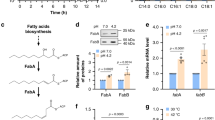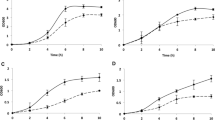Abstract
Enterococcus faecalis is a commensal bacterium of the human gut that requires the ability to pass through the stomach and therefore cope with low pH. E. faecalis has also been identified as one of the major tyramine producers in fermented food products, where they also encounter acidic environments. In the present work, we have constructed a non-tyramine-producing mutant to study the role of the tyramine biosynthetic pathway, which converts tyrosine to tyramine via amino acid decarboxylation. Wild-type strain showed higher survival in a system that mimics gastrointestinal stress, indicating that the tyramine biosynthetic pathway has a role in acid resistance. Transcriptional analyses of the E. faecalis V583 tyrosine decarboxylase cluster showed that an acidic pH, together with substrate availability, induces its expression and therefore the production of tyramine. The protective role of the tyramine pathway under acidic conditions appears to be exerted through the maintenance of the cytosolic pH. Tyramine production should be considered important in the adaptability of E. faecalis to acidic environments, such as fermented dairy foods, and to survive passage through the human gastrointestinal tract.





Similar content being viewed by others
References
Agudelo Higuita N, Huycke M (2014) Enterococcal disease, epidemiology, and implications for treatment. In: Gilmore MS, Clewell DB, Ike Y, Shankar N (eds) Enterococci: from commensals to leading causes of drug resistant infection. Massachusetts Eye and Ear Infirmary, Boston
Biswas I, Gruss A, Ehrlich SD, Maguin E (1993) High-efficiency gene inactivation and replacement system for gram-positive bacteria. J Bacteriol 175(11):3628–3635
Bonten MJ, Willems R, Weinstein RA (2001) Vancomycin-resistant enterococci: why are they here, and where do they come from? Lancet Infect Dis 1(5):314–325
Breeuwer P, Drocourt J, Rombouts FM, Abee T (1996) A novel method for continuous determination of the intracellular ph in bacteria with the internally conjugated fluorescent probe 5 (and 6-)-carboxyfluorescein succinimidyl ester. Appl Environ Microbiol 62(1):178–183
Calles-Enriquez M, Eriksen BH, Andersen PS, Rattray FP, Johansen AH, Fernandez M, Ladero V, Alvarez MA (2010) Sequencing and transcriptional analysis of the Streptococcus thermophilus histamine biosynthesis gene cluster: factors that affect differential hdcA expression. Appl Environ Microbiol 76(18):6231–6238. doi:10.1128/AEM. 00827-10
Castanie-Cornet MP, Foster JW (2001) Escherichia coli acid resistance: cAMP receptor protein and a 20 bp cis-acting sequence control pH and stationary phase expression of the gadA and gadBC glutamate decarboxylase genes. Microbiology 147:709–715
Connil N, Le Breton Y, Dousset X, Auffray Y, Rince A, Prevost H (2002) Identification of the Enterococcus faecalis tyrosine decarboxylase operon involved in tyramine production. Appl Environ Microbiol 68(7):3537–3544
Coton M, Fernandez M, Trip H, Ladero V, Mulder NL, Lolkema JS, Alvarez MA, Coton E (2011) Characterization of the tyramine-producing pathway in Sporolactobacillus sp. P3J. Microbiol 157:1841–1849. doi:10.1099/mic. 0.046367-0
EFSA (2011) Scientific Opinion on risk based control of biogenic amine formation in fermented foods. EFSA Panel on Biological Hazards (BIOHAZ). EFSA J 9(10):2393–2486
Fernandez de Palencia P, Fernandez M, Mohedano ML, Ladero V, Quevedo C, Alvarez MA, Lopez P (2011) Role of tyramine synthesis by food-borne Enterococcus durans in adaptation to the gastrointestinal tract environment. Appl Environ Microbiol 77(2):699–702. doi:10.1128/AEM. 01411-10
Fernández de Palencia P, López P, Corbí A, Peláez C, Requena T (2008) Probiotic strains: survival under simulated gastrointestinal conditions, in vitro adhesion to Caco-2 cells and effect on cytokine secretion. Eur Food Res Technol 227(5):1475–1484. doi:10.1007/s00217-008-0870-6
Fernandez M, Linares DM, Alvarez MA (2004) Sequencing of the tyrosine decarboxylase cluster of Lactococcus lactis IPLA 655 and the development of a PCR method for detecting tyrosine decarboxylating lactic acid bacteria. J Food Prot 67(11):2521–2529
Fernandez M, Linares DM, Del Rio B, Ladero V, Alvarez MA (2007a) HPLC quantification of biogenic amines in cheeses: correlation with PCR-detection of tyramine-producing microorganisms. J Dairy Res 74(3):276–282. doi:10.1017/S0022029907002488
Fernandez M, Linares DM, Rodriguez A, Alvarez MA (2007b) Factors affecting tyramine production in Enterococcus durans IPLA 655. Appl Microbiol Biotechnol 73(6):1400–1406. doi:10.1007/s00253-006-0596-y
Gahan CG, Hill C (2014) Listeria monocytogenes: survival and adaptation in the gastrointestinal tract. Front Cell Infect Microbiol 4:9. doi:10.3389/fcimb.2014.00009
Giraffa G (2003) Functionality of enterococci in dairy products. Int J Food Microbiol 88(2–3):215–222
Green MR, Sambrook J (2012) Molecular cloning: a laboratory manual, 4th edn. Cold Spring Harbor Laboratory Press, Cold Spring Harbor
Grundy FJ, Moir TR, Haldeman MT, Henkin TM (2002) Sequence requirements for terminators and antiterminators in the T box transcription antitermination system: disparity between conservation and functional requirements. Nucleic Acids Res 30(7):1646–1655
Holo H, Nes IF (1989) High-frequency transformation, by electroporation, of Lactococcus lactis subsp. cremoris grown with glycine in osmotically stabilized media. Appl Environ Microbiol 55(12):3119–3123
Horton RM, Hunt HD, Ho SN, Pullen JK, Pease LR (1989) Engineering hybrid genes without the use of restriction enzymes: gene splicing by overlap extension. Gene 77(1):61–68
Jonsson M, Saleihan Z, Nes IF, Holo H (2009) Construction and characterization of three lactate dehydrogenase-negative Enterococcus faecalis V583 mutants. Appl Environ Microbiol 75(14):4901–4903
Ladero V, Calles-Enríquez M, Fernández M, Alvarez MA (2010a) Toxicological effects of dietary biogenic amines. Curr Nutr Food Sci 6:145–156
Ladero V, Fernandez M, Calles-Enriquez M, Sanchez-Llana E, Canedo E, Martin MC, Alvarez MA (2012) Is the production of the biogenic amines tyramine and putrescine a species-level trait in enterococci? Food Microbiol 30(1):132–138. doi:10.1016/j.fm.2011.12.016
Ladero V, Fernandez M, Cuesta I, Alvarez MA (2010b) Quantitative detection and identification of tyramine-producing enterococci and lactobacilli in cheese by multiplex qPCR. Food Microbiol 27(7):933–939. doi:10.1016/j.fm.2010.05.026
Ladero V, Linares DM, Del Rio B, Fernandez M, Martin MC, Alvarez MA (2013) Draft genome sequence of the tyramine producer Enterococcus durans strain IPLA 655. Genome Announc 1:e00265–13. doi:10.1128/genomeA. 00265-13
Lebreton F, Willems R, Gilmore M (2014) Enterococcus diversity, origins in nature, and gut colonization. In: Gilmore MS, Clewell DB, Ike Y, Shankar N (eds) Enterococci: from commensals to leading causes of drug resistant infection. Massachusetts Eye and Ear Infirmary, Boston
Linares DM, Del Rio B, Ladero V, Martinez N, Fernandez M, Martin MC, Alvarez MA (2012a) Factors influencing biogenic amines accumulation in dairy products. Front Microbiol 3:180. doi:10.3389/fmicb.2012.00180
Linares DM, Fernandez M, Del-Rio B, Ladero V, Martin MC, Alvarez MA (2012b) The tyrosyl-tRNA synthetase like gene located in the tyramine biosynthesis cluster of Enterococcus durans is transcriptionally regulated by tyrosine concentration and extracellular pH. BMC Microbiol 12:23. doi:10.1186/1471-2180-12-23
Linares DM, Fernandez M, Martin MC, Alvarez MA (2009) Tyramine biosynthesis in Enterococcus durans is transcriptionally regulated by the extracellular pH and tyrosine concentration. Microb Biotechnol 2(6):625–633. doi:10.1111/j.1751-7915.2009.00117.x
Linares DM, Martin MC, Ladero V, Alvarez MA, Fernandez M (2011) Biogenic amines in dairy products. Crit Rev Food Sci Nutr 51(7):691–703. doi:10.1080/10408398.2011.582813
Livak KJ, Schmittgen TD (2001) Analysis of relative gene expression data using real-time quantitative PCR and the 2(−delta delta C(T)) method. Methods 25(4):402–408. doi:10.1006/meth.2001.1262
Lucas P, Landete J, Coton M, Coton E, Lonvaud-Funel A (2003) The tyrosine decarboxylase operon of Lactobacillus brevis IOEB 9809: characterization and conservation in tyramine-producing bacteria. FEMS Microbiol Lett 229(1):65–71
Lund P, Tramonti A, De Biase D (2014) Coping with low pH: molecular strategies in neutralophilic bacteria. FEMS Microbiol Rev 4(10):1574–6976. doi:10.1111/1574-6976.12076
Lyte M (2004) The Biogenic amine tyramine modulates the adherence of Escherichia coli O157: H7 to intestinal mucosa. J Food Prot 67(5):878–883
Marcobal A, de las Rivas B, Munoz R (2006a) First genetic characterization of a bacterial beta-phenylethylamine biosynthetic enzyme in Enterococcus faecium RM58. FEMS Microbiol Lett 258(1):144–149. doi:10.1111/j.1574-6968.2006.00206.x
Marcobal A, Martin-Alvarez PJ, Moreno-Arribas MV, Munoz R (2006b) A multifactorial design for studying factors influencing growth and tyramine production of the lactic acid bacteria Lactobacillus brevis CECT 4669 and Enterococcus faecium BIFI-58. Res Microbiol 157(5):417–424. doi:10.1016/j.resmic.2005.11.006
Mathur S, Singh R (2005) Antibiotic resistance in food lactic acid bacteria-a review. Int J Food Microbiol 105(3):281–295. doi:10.1016/j.ijfoodmicro.2005.03.008
Molenaar D, Abee T, Konings WN (1991) Continuous measurement of the cytoplasmic pH in Lactococcus lactis with a fluorescent pH indicator. Biochim Biophys Acta 1115(1):75–83
Nes IF, Diep DB, Ike Y (2014) Enterococcal bacteriocins and antimicrobial proteins that contribute to niche control. In: Gilmore MS, Clewell DB, Ike Y, Shankar N (eds) Enterococci: from commensals to leading causes of drug resistant infection. Massachusetts Eye and Ear Infirmary, Boston
Paulsen IT, Banerjei L, Myers GS, Nelson KE, Seshadri R, Read TD, Fouts DE, Eisen JA, Gill SR, Heidelberg JF, Tettelin H, Dodson RJ, Umayam L, Brinkac L, Beanan M, Daugherty S, DeBoy RT, Durkin S, Kolonay J, Madupu R, Nelson W, Vamathevan J, Tran B, Upton J, Hansen T, Shetty J, Khouri H, Utterback T, Radune D, Ketchum KA, Dougherty BA, Fraser CM (2003) Role of mobile DNA in the evolution of vancomycin-resistant Enterococcus faecalis. Science 299(5615):2071–2074
Pereira CI, Matos D, Romao MVS, Crespo MTB (2009) Dual role for the tyrosine decarboxylation pathway in Enterococcus faecium E17: response to an acid challenge and generation of a proton motive force. Appl Environ Microbiol 75(2):345–352. doi:10.1128/AEM. 01958-08
Pessione E (2012) Lactic acid bacteria contribution to gut microbiota complexity: lights and shadows. Front Cell Infect Microbiol 2:86. doi:10.3389/fcimb.2012.00086
Pessione E, Pessione A, Lamberti C, Coisson DJ, Riedel K, Mazzoli R, Bonetta S, Eberl L, Giunta C (2009) First evidence of a membrane-bound, tyramine and beta-phenylethylamine producing, tyrosine decarboxylase in Enterococcus faecalis: a two-dimensional electrophoresis proteomic study. Proteomics 9(10):2695–2710. doi:10.1002/pmic.200800780
Poolman B, Konings WN (1988) Relation of growth of Streptococcus lactis and Streptococcus cremoris to amino acid transport. J Bacteriol 170(2):700–707
Redruello B, Ladero V, Cuesta I, Alvarez-Buylla JR, Martin MC, Fernandez M, Alvarez MA (2013) A fast, reliable, ultra high performance liquid chromatography method for the simultaneous determination of amino acids, biogenic amines and ammonium ions in cheese, using diethyl ethoxymethylenemalonate as a derivatising agent. Food Chem 139(1–4):1029–1035. doi:10.1016/j.foodchem.2013.01.071
Romano A, Ladero V, Alvarez MA, Lucas PM (2014) Putrescine production via the ornithine decarboxylation pathway improves the acid stress survival of Lactobacillus brevis and is part of a horizontally transferred acid resistance locus. Int J Food Microbiol 175:14–19. doi:10.1016/j.ijfoodmicro.2014.01.009
Russo P, Fernandez de Palencia P, Romano A, Fernandez M, Lucas P, Spano G, Lopez P (2012) Biogenic amine production by the wine Lactobacillus brevis IOEB 9809 in systems that partially mimic the gastrointestinal tract stress. BMC Microbiol 12:247. doi:10.1186/1471-2180-12-247
Sanchez B, de los Reyes-Gavilan CG, Margolles A (2006) The F1F0-ATPase of Bifidobacterium animalis is involved in bile tolerance. Environ Microbiol 8(10):1825–1833
Solheim M, La Rosa SL, Mathisen T, Snipen LG, Nes IF, Brede DA (2014) Transcriptomic and functional analysis of NaCl-induced stress in Enterococcus faecalis. PLoS One 9:e94571. doi:10.1371/journal.pone.0094571
Trip H, Mulder NL, Lolkema JS (2012) Improved acid stress survival of Lactococcus lactis expressing the histidine decarboxylation pathway of Streptococcus thermophilus CHCC1524. J Biol Chem 287(14):11195–11204. doi:10.1074/jbc.M111.330704
Ubeda C, Taur Y, Jenq RR, Equinda MJ, Son T, Samstein M, Viale A, Socci ND, van den Brink MR, Kamboj M, Pamer EG (2010) Vancomycin-resistant Enterococcus domination of intestinal microbiota is enabled by antibiotic treatment in mice and precedes bloodstream invasion in humans. J Clin Invest 120(12):4332–4341. doi:10.1172/JCI43918
Van den Abbeele P, Grootaert C, Marzorati M, Possemiers S, Verstraete W, Gerard P, Rabot S, Bruneau A, El Aidy S, Derrien M, Zoetendal E, Kleerebezem M, Smidt H, Van de Wiele T (2010) Microbial community development in a dynamic gut model is reproducible, colon region specific, and selective for Bacteroidetes and Clostridium cluster IX. Appl Environ Microbiol 76(15):5237–5246. doi:10.1128/AEM. 00759-10
Wolken WA, Lucas PM, Lonvaud-Funel A, Lolkema JS (2006) The mechanism of the tyrosine transporter TyrP supports a proton motive tyrosine decarboxylation pathway in Lactobacillus brevis. J Bacteriol 188(6):2198–2206. doi:10.1128/JB.188.6.2198-2206.2006
Acknowledgments
This work was funded by the Ministry of Economy and Competitiveness, Spain (AGL2013-45431-R) and the Spanish National Research Council (CSIC201270E144). M.P. is beneficiary of an FPU fellowship from the Spanish Ministry of Education. We thank Pilar Fernández de Palencia and Paloma López for their help in the GIT survival experiments. The authors also thank Adrian Burton for language and editing assistance.
Author information
Authors and Affiliations
Corresponding author
Electronic supplementary material
Below is the link to the electronic supplementary material.
ESM 1
(PDF 236 kb)
Rights and permissions
About this article
Cite this article
Perez, M., Calles-Enríquez, M., Nes, I. et al. Tyramine biosynthesis is transcriptionally induced at low pH and improves the fitness of Enterococcus faecalis in acidic environments. Appl Microbiol Biotechnol 99, 3547–3558 (2015). https://doi.org/10.1007/s00253-014-6301-7
Received:
Revised:
Accepted:
Published:
Issue Date:
DOI: https://doi.org/10.1007/s00253-014-6301-7




